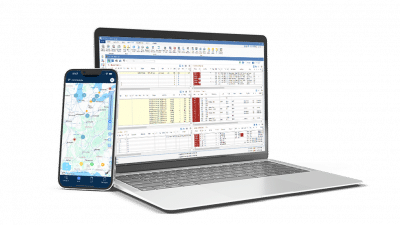Productivity directly impacts your fleet’s profitability. Idle trucks, missed deliveries, and inefficient routes drive up your costs. For fleet managers, the challenge lies in identifying these productivity gaps and putting solutions in place that keep vehicles moving efficiently.
This post explores the most common roadblocks to fleet productivity and provides practical strategies to overcome them, from optimizing routes to enhancing team coordination and leveraging management software.
Common Barriers to Fleet Productivity
Fleet managers know that even the best-maintained trucks become costly without efficient operations to support them. These are the biggest obstacles that can slow down your fleet:
- Inefficient route planning: Poorly planned routes lead to wasted fuel, delayed deliveries, and extra mileage.
- Unscheduled downtime: Breakdowns and unplanned maintenance stop your fleet, disrupting delivery schedules.
- Communication gaps: When dispatchers, drivers, and managers miscommunicate, it leads to missed instructions, delayed responses, and confusion.
- Manual administrative tasks: Paperwork and manual data entry slow processes down and increase the risk of errors.
- Compliance challenges: Staying compliant and managing records can be time-consuming, distracting teams from core tasks.
- Unclear performance: Without real-time data, managers struggle to monitor vehicle performance, fuel consumption, and driver behavior, making problem-solving harder.
Understanding these barriers is the first step to overcoming them.
Strategies to Improve Fleet Productivity
To keep your fleet running efficiently, you need three things: effective planning, clear communication, and the right technology. Here are seven actionable strategies to enhance fleet productivity:
1. Optimize route planning
Use GPS tracking and route optimization software to ensure drivers take the most efficient routes, reducing fuel consumption and avoiding traffic. Regularly review routes to spot problem areas and adjust for factors like road closures or peak traffic times. For fleets with flexible schedules, consider software with real-time traffic updates that automatically reroute drivers.
2. Implement preventive maintenance
Preventive maintenance keeps your vehicles on the road and minimizes costly breakdowns. Establish a regular maintenance schedule for each vehicle, covering essentials like oil changes, tire rotations, and brake checks. Use fleet management software to set reminders and track completed maintenance, ensuring nothing gets missed.
3. Improve driver communication
Clear, consistent communication between drivers and fleet managers is important. Provide drivers with reliable mobile apps or devices for real-time updates and instructions. Make sure they know how to report issues, request assistance, or clarify route details. Regular check-ins can help identify concerns before they become problems.
4. Automate administrative tasks
Manual paperwork slows operations and increases the risk of mistakes. Fleet management software automates data entry, billing, and record-keeping. Digital forms replace paper logs, while automated reporting saves hours of administrative time each week.
5. Ensure compliance with regulations
Regulations can be complex, but staying compliant is essential. Use digital tools to track driver hours, maintain inspection records, and ensure your vehicles meet all legal requirements. Stay ahead of regulation changes with automated alerts, avoiding costly fines.
6. Get real-time data
Stay on top of your fleet’s performance with real-time data. Telematics systems let you monitor vehicle speed, fuel consumption, driver behavior, and route efficiency. Use this data to identify problems like excessive idling or harsh braking and make data-driven improvements.
7. Reward efficient driving habits
Encourage safe and efficient driving by recognizing drivers who maintain high standards. Use telematics data to track key behaviors, such as smooth acceleration and minimal idling. Motivate drivers with incentives like gift cards, bonuses, or public recognition.
How Fleet Management Software Boosts Productivity
Fleet managers juggle a lot, from route planning to maintenance, driver communication, compliance, and data tracking. A transportation management system (TMS) cuts through the chaos, simplifying each task to improve fleet productivity.
Effective route planning
A TMS helps you plan the best routes for your drivers, avoiding traffic and saving fuel. With automated route optimization, drivers can get to their destinations faster and with less hassle.
Automatic maintenance reminders
Never miss a maintenance check again. A TMS tracks service schedules for each vehicle and sends reminders when maintenance is due. This keeps your fleet in top shape and reduces the chance of unexpected breakdowns.
Clear driver communication
A TMS makes it easy to send drivers real-time updates, route changes, or important instructions. Drivers can also report problems or ask questions directly through the system, keeping everyone connected.
Easy compliance tracking
Staying compliant with industry rules is a must, but it can be a headache. A TMS tracks driver hours, vehicle inspections, and other records automatically, making it easier to stay on the right side of regulations.
Actionable data insights
A TMS collects data on your fleet’s performance, like fuel usage, idle time, and driver behavior. Use this information to spot problems, make improvements, and keep your fleet running smoothly.
Less paperwork
Automate tedious tasks like data entry, billing, and reporting. A TMS reduces paperwork, minimizes errors, and frees up your team to focus on more important work.
A TMS isn’t just about keeping your fleet running — it helps your team work faster, safer, and at lower costs.
PCS Customer Success Story: Ferrara Transport Services
Ferrara Transport Services, a growing logistics company, faced operational challenges with their outdated management system. Limited visibility into fleet performance, manual workflows, and training difficulties were just a few of the issues that hindered their growth.
But when Ferrara switched to PCS’s TMS, here is what changed.
- Improved decision-making: The new TMS provided real-time and historical insights, empowering Ferrara to make smarter operational decisions.
- Increased efficiency: Automation of routine tasks reduced manual workloads, allowing staff to focus on strategic activities.
- Enhanced training: The user-friendly system made onboarding and training new team members faster and more effective.
Ferrara Transport’s experience is just one of many success stories that show why PCS is the preferred TMS for carriers.
Improve Fleet Productivity With PCS
Take control of your fleet’s productivity with PCS Software. Our TMS empowers you to streamline your operations and cut costs.
- Automate administrative tasks: Eliminate manual data entry and paperwork. PCS’s TMS automates billing, record-keeping, and reporting.
- Optimize route planning: Use GPS tracking and route optimization tools to minimize travel time and fuel costs.
- Enhance driver communication: Keep drivers connected with real-time updates and direct messaging.
- Ensure compliance: Stay compliant with automated tracking and accurate record-keeping.
- Get real-time data: Access insights on vehicle performance, fuel consumption, and driver behavior.
Request your personalized demo today and see how the PCS TMS can help you improve fleet productivity.



